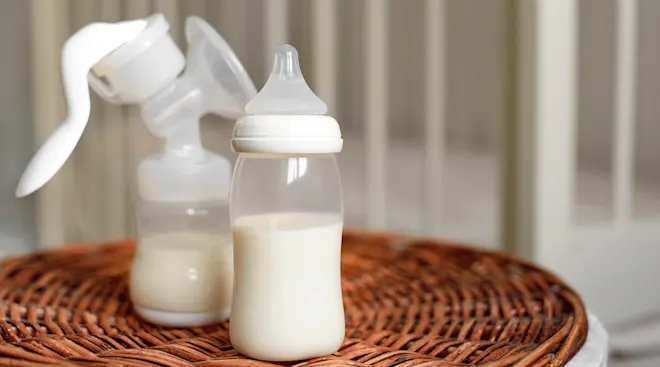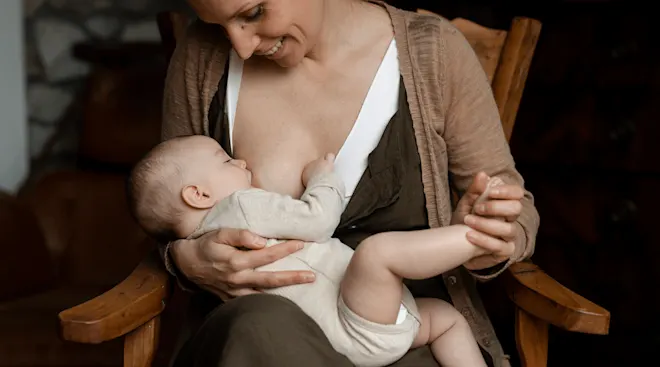Why You Might Experience Cramping While Breastfeeding
Breastfeeding might give you plenty of opportunities for snuggles with your little one—but it can also be uncomfortable at times. One example? You might notice some twinges or even pain in your abdomen after baby latches. Yes, cramping while breastfeeding is a thing.
The good news is that postpartum cramps while breastfeeding generally don’t last too long. But it’s understandable to have questions about why it feels like you’re experiencing period cramps when you breastfeed. Ahead, experts break down the science behind breastfeeding cramps—plus how to get relief.
Yes, breastfeeding cramps are normal—and pretty common. “It’s absolutely normal to have cramping when you breastfeed,” says Haylea Sweat Patrick, MD, assistant professor in the Division of Maternal-Fetal Medicine at Rutgers Robert Wood Johnson Medical School. “It’s a sign that physiologically, everything’s working as it should after delivery.”
While any new mom can experience breastfeeding cramps, “people tend to feel it more with the second, third and fourth babies—[you] may not feel it as much with the first baby,” says Jennifer Leighdon Wu, MD, an ob-gyn at Northwell Lenox Hill Hospital in New York City.
There are a few things that cause cramping during breastfeeding. It’s important to remember that your uterus stretches out during pregnancy to accommodate a growing baby—and it needs to shrink back down again. Breastfeeding can help with the process, says Matthew Carroll, MD, assistant professor of obstetrics and gynecology at Baylor College of Medicine in Houston.
“Breastfeeding stimulates the release of oxytocin, a hormone that has many effects in a postpartum mother,” Carroll says. “It stimulates the uterus to contract, which causes those cramps.”
Oxytocin (aka the “love hormone”), which also causes labor contractions, is released by the pituitary gland in the brain and causes the let-down reflex that allows milk to flow during breastfeeding, Patrick explains. “The uterus is actually contracting during breastfeeding, which is why some people describe cramping during breastfeeding as ‘after pains,’” she says.
While they’re uncomfortable, the cramps help the uterus contract back down to its normal size after delivery, which is a process that takes several weeks, Patrick says. “This cramping is also protective against heavy bleeding after delivery, as those contractions help to clamp down on the blood vessels in the uterus,” she adds.
There are a few different things you can do to get relief from cramps while breastfeeding. “Anything that soothes a sore muscle or aids the discomfort you feel on your period can help,” Carroll says. That includes:
- Using a warm or hot compress. You can apply this directly to your abdomen. This can help to increase blood flow to the area and relax the muscles.
- Taking an OTC medication. Advil (ibuprofen) and Tylenol (acetaminophen) can help reduce discomfort from cramps, Patrick says.
- Peeing regularly. “Emptying your bladder on a regular basis can help, as having a full bladder may make the cramping worse,” Patrick says. (You can also try peeing right before you breastfeed.)
- Sitting “pretzel-style” while you nurse. This position helps to bring your uterus forward and relieves pressure on the area, according to the American Academy of Pediatrics (AAP).
Breastfeeding cramps tend to get better in the early postpartum period. “The worst cramps usually occur in the first days to a week after birth,” Carroll says. “Most people feel some improvement by the time they leave the hospital.”
Patrick agrees. “It typically does lessen in intensity over time as the uterus contracts back down closer to its normal size,” she says. However, Carroll adds that “it can take the entire six weeks of initial healing before the cramps really improve.”
Again, breastfeeding cramps tend to get better over time. But if they seem to be abnormally severe or you’re having heavy bleeding with the cramps, Wu says it’s a good idea to contact your healthcare provider. If you have a fever with your cramps, it’s also important to reach out, Carroll says.
Breastfeeding cramps aren’t fun, but there are things you can do to relieve them and get more comfortable. Patrick says it’s helpful to remember that cramps while nursing are actually “a good thing,” since they mean your uterus is healing. Basically, your postpartum body is doing exactly what it should be!
Please note: The Bump and the materials and information it contains are not intended to, and do not constitute, medical or other health advice or diagnosis and should not be used as such. You should always consult with a qualified physician or health professional about your specific circumstances.
Plus, more from The Bump:
Matthew Carroll, MD, is an assistant professor of obstetrics and gynecology at Baylor College of Medicine. He received his medical degree from Mount Sinai School of Medicine.
Haylea Sweat Patrick, MD, is an assistant professor in the Division of Maternal-Fetal Medicine at Rutgers Robert Wood Johnson Medical School. She earned her medical degree from the University of Kentucky College of Medicine.
Jennifer Leighdon Wu, MD, is an ob-gyn at Northwell Lenox Hill Hospital in New York City. She earned her medical degree from the University of South Carolina at Charleston.
Healthy Children (American Academy of Pediatrics), Nursing Cramps, December 2011
Learn how we ensure the accuracy of our content through our editorial and medical review process.
Navigate forward to interact with the calendar and select a date. Press the question mark key to get the keyboard shortcuts for changing dates.




















































